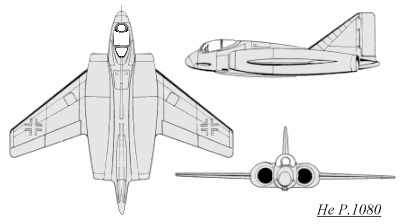 Heinkel designed this ramjet-powered fighter after receiving ramjet data
from DFS near the end of WWII. Two 900 mm (2' 11.5") diameter Lorin-Rohr
ramjets were mounted on each side of the fuselage with their outer surfaces
faired into the wing, so that the large surface area of the ramjets were
exposed to the airstream for cooling purposes. To save design time, the
swept-back wing with the elevon controls were based on those of the He
P.1078, but a single orthodox fin and rudder was used instead of wingtip
anhedral. The cockpit was located in the forward section of the fuselage,
along with a radar unit and two MK 108 30mm cannon. The fuel tanks were
located in the rear of the fuselage. Take-off power was accomplished with
the aid of four solid-fuel rockets of 1000 kg (2200 lbs) of thrust each.
An undercarriage that could be jettisoned was used on take-off and landing
was done on an extendable skid.
Heinkel designed this ramjet-powered fighter after receiving ramjet data
from DFS near the end of WWII. Two 900 mm (2' 11.5") diameter Lorin-Rohr
ramjets were mounted on each side of the fuselage with their outer surfaces
faired into the wing, so that the large surface area of the ramjets were
exposed to the airstream for cooling purposes. To save design time, the
swept-back wing with the elevon controls were based on those of the He
P.1078, but a single orthodox fin and rudder was used instead of wingtip
anhedral. The cockpit was located in the forward section of the fuselage,
along with a radar unit and two MK 108 30mm cannon. The fuel tanks were
located in the rear of the fuselage. Take-off power was accomplished with
the aid of four solid-fuel rockets of 1000 kg (2200 lbs) of thrust each.
An undercarriage that could be jettisoned was used on take-off and landing
was done on an extendable skid.
![]() Josha Hildwine's He P.1080 Luft Art images
Josha Hildwine's He P.1080 Luft Art images
Span: 8.9 m (29' 2.7") Length: 8.15 m (26' 9.1") Max. Speed: 1000 km/h (621 mph)